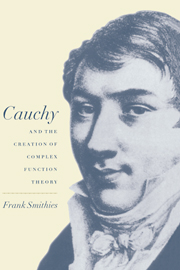Book contents
- Frontmatter
- Contents
- Introduction
- 1 The background to Cauchy's work on complex function theory
- 2 Cauchy's 1814 memoir on definite integrals
- 3 Miscellaneous contributions (1815–1825)
- 4 The 1825 memoir and associated articles
- 5 The calculus of residues
- 6 The Lagrange series and the Turin memoirs
- 7 Summary and conclusions
- References
- Notation index
- Author index
- Subject index
7 - Summary and conclusions
Published online by Cambridge University Press: 10 October 2009
- Frontmatter
- Contents
- Introduction
- 1 The background to Cauchy's work on complex function theory
- 2 Cauchy's 1814 memoir on definite integrals
- 3 Miscellaneous contributions (1815–1825)
- 4 The 1825 memoir and associated articles
- 5 The calculus of residues
- 6 The Lagrange series and the Turin memoirs
- 7 Summary and conclusions
- References
- Notation index
- Author index
- Subject index
Summary
7.1. In the last six chapters we have analysed Cauchy's work on complex function theory from 1814 to 1831, and we have indicated some of the background to the development of his ideas. In the present chapter we shall try to draw the threads together. There are several themes that recur throughout the story; we shall look at these in turn, and try to trace how Cauchy's approach to each of them changed during the period.
To begin with, we shall have to say something about the kind of functions that Cauchy regarded as admissible, and then about the development of his concept of the integral. After a brief sketch of some earlier ideas about complex functions and about techniques for the evaluation of definite integrals, we shall show how, by combining some of these ideas, he was able to obtain results equivalent to special cases of ‘Cauchy's theorem’ and the residue theorem. We shall then follow the development of his techniques, which enabled him to establish more general forms of these results, and we shall indicate the role played here by his tentative introduction and gradually increasing use of a geometrical picture of the complex plane.
- Type
- Chapter
- Information
- Cauchy and the Creation of Complex Function Theory , pp. 186 - 204Publisher: Cambridge University PressPrint publication year: 1997



